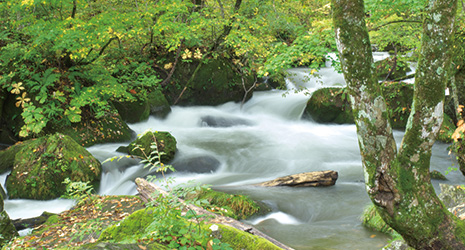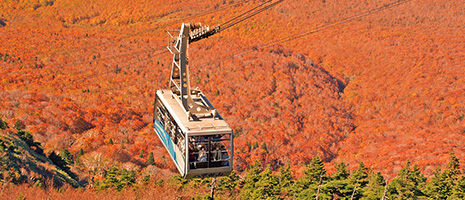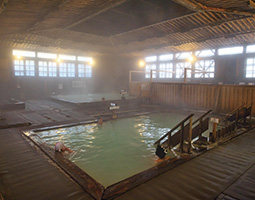INDEX
- English
- 日本語

The Oirase Keiryu mountain stream - English
- 日本語

A gondola passes over the Hakkoda mountains in autumn


The spacious hiba sennin-buro bathhouse at Sukayu Onsen Ryokan 
The “Maiden Statue” by Takamura Kotaro
May 2020
Towada-Hachimantai: A Joy for All Seasons

Blessed with deep forests, crystal clear mountain streams, waterfalls and a mighty lake, Towada-Hachimantai National Park is a place of magnificent natural beauty all year round. This scenic part of the Tohoku region is also well known for its various hot springs.

Towada-Hachimantai National Park is located in mountainous northern Honshu (main island of Japan) and is divided into two main areas — the Towada-Hakkoda area, location of Lake Towada, the Oirase-Keiryu mountain stream and the Hakkoda mountain range; and the Hachimantai area, with Mt. Hachimantai, Mt. Akita-Komagatake and Mt. Iwate. Situated in one of the most prominent volcanic regions of Japan, this National Park has a varied topography and diverse ecosystem produced over a long period by volcanic phenomena and the heavy snowfall in winter.
Lake Towada, for example, is a double caldera lake formed by volcanic activity that commenced approximately 200,000 years ago. The trees surrounding the crater rim help form a primeval landscape which changes throughout the year, being draped by a sea of clouds in spring and summer, colorful leaves in autumn, and snow and ice in winter.
The “Maiden Statue” that stands on the shore of Lake Towada is by the prominent sculptor and poet Takamura Kotaro (1883–1958). Although it has a secluded location, the statue is a popular attraction and a symbol of the lake.

A ravine shaped by the Oirase River has been designated as a special place of scenic beauty and a natural monument by the Japanese government, together with Lake Towada from which the Oirase River flows. Stretching about 14 kilometers, the ravine is a treasure trove of deciduous broad-leaved trees; graceful in spring, lush in the early summer and of matchless beauty in the autumn when the leaves change their color. There is a promenade along the Oirase Keiryu mountain stream which cuts through the giant trees and along which are scattered waterfalls and fantastically shaped rocks covered with moss.
A national road along the ravine is another course covered with trees that affords magnificent views over the towering mountains of Hakkoda. The course is dotted with marshes, including Suiren Marsh, which is surrounded by frost-covered trees in winter, and Jigoku Marsh, where hot water with a temperature of more than 90 degrees centigrade gushes out.
The highest peak in the Hakkoda mountain range is Mt. Odake with a height of 1,585 meters. The mountain range stretching south spans a group of volcanos from Mt. Takada-Odake and Mt. Akakuradake to Mt. Kushigamine, Mt. Komagamine, Mt. Norikuradake and Mt. Yokodake. The mountain trails and ropeway, which operates all year round, offer panoramic views of an ever-changing tapestry of colorful leaves and, in the winter, frost-covered trees.

There are natural forests, fields of alpine plants along mountain ridges and wetlands in the Hakkoda mountain range, which is a popular ski resort. In the New Year, one road through the area becomes a snow corridor with walls more than five meters high. The mountain range is full of landscapes that are both graceful and grand.
At the foot of the mountains are numerous hot springs, such as Jogakura, Sukayu, Sarukura, Yachi and Tsuta, which are popular for relaxation and therapeutic purposes. There are various intriguing legends about the discovery of the hot springs, including wounded deer and monkeys found soaking in the hot water. The traditional wooden buildings of the Japanese-style inns have a special charm.
Sukayu Onsen Ryokan (Sukayu Hot Spring Inn) has been visited by people seeking hot spring cures since the Edo period (1603–1867). This hot spring on a hill surrounded by Japanese beeches is famous for its hiba (cypress) sennin-buro, a gigantic bathhouse big enough for “one thousand people.” There are four bathtubs filled with hot spring water from four different fountainheads in the bathhouse, which is the size of a 160 tatami-mat room (265 m2). The Inn welcomes day visitors as well as long-term guests seeking a hot spring cure.

Such inexhaustible charms attract people to Towada-Hachimantai National Park all year round.
(This is a revised version of the article that appeared in the November 2017 issue of Highlighting Japan.)

